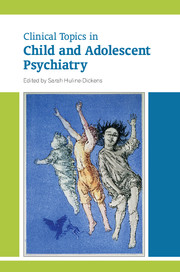Book contents
- Frontmatter
- Contents
- List of tables
- List of boxes
- List of figures
- List of contributors
- Preface
- 1 Child psychiatry and the people who have shaped it
- 2 Fabrication and induction of illness in children
- 3 Personality disorders as disorganisation of attachment and affect regulation
- 4 Post-traumatic stress disorder and attachment: possible links with borderline personality disorder
- 5 Management of antisocial behaviour in childhood
- 6 Pharmacology for attention-deficit hyperactivity disorder, Tourette syndrome and autism spectrum disorder
- 7 Pharmacology for anxiety and obsessive–compulsive disorders, affective disorders and schizophrenia
- 8 Pharmacological management of core and comorbid symptoms in autism spectrum disorder
- 9 Pharmacological treatment of depression and bipolar disorder
- 10 Cognitive–behavioural therapy with children, young people and families: from individual to systemic therapy
- 11 Anxiety disorders
- 12 Somatising: clinical presentations and aetiological factors
- 13 Somatising: management and outcomes
- 14 Evaluating psychological treatments for children with autism
- 15 Attention-deficit hyperactivity disorder: assessment and treatment
- 16 Schizophrenia
- 17 Tourette syndrome
- 18 Sleep disorders
- 19 Self-harm in adolescents
- 20 Adolescent substance misuse: an update on behaviours and treatments
- 21 Eating disorders
- 22 Gender dysphoria in young people
- 23 The psychiatry of children aged 0–4
- Index
19 - Self-harm in adolescents
Published online by Cambridge University Press: 02 January 2018
- Frontmatter
- Contents
- List of tables
- List of boxes
- List of figures
- List of contributors
- Preface
- 1 Child psychiatry and the people who have shaped it
- 2 Fabrication and induction of illness in children
- 3 Personality disorders as disorganisation of attachment and affect regulation
- 4 Post-traumatic stress disorder and attachment: possible links with borderline personality disorder
- 5 Management of antisocial behaviour in childhood
- 6 Pharmacology for attention-deficit hyperactivity disorder, Tourette syndrome and autism spectrum disorder
- 7 Pharmacology for anxiety and obsessive–compulsive disorders, affective disorders and schizophrenia
- 8 Pharmacological management of core and comorbid symptoms in autism spectrum disorder
- 9 Pharmacological treatment of depression and bipolar disorder
- 10 Cognitive–behavioural therapy with children, young people and families: from individual to systemic therapy
- 11 Anxiety disorders
- 12 Somatising: clinical presentations and aetiological factors
- 13 Somatising: management and outcomes
- 14 Evaluating psychological treatments for children with autism
- 15 Attention-deficit hyperactivity disorder: assessment and treatment
- 16 Schizophrenia
- 17 Tourette syndrome
- 18 Sleep disorders
- 19 Self-harm in adolescents
- 20 Adolescent substance misuse: an update on behaviours and treatments
- 21 Eating disorders
- 22 Gender dysphoria in young people
- 23 The psychiatry of children aged 0–4
- Index
Summary
The National Institute for Health and Care Excellence (NICE) has defined self-harming behaviour as:
‘an expression of personal distress, usually made in private, by an individual who hurts him or herself. The nature and meaning of self-harm, however, vary greatly from person to person. In addition, the reason a person harms him or herself may be different on each occasion, and should not be presumed to be the same’ (National Institute for Clinical Excellence, 2004: p. 8).
Self-harm can be divided into two broad types: self-injury and selfpoisoning. The definition of self-harm is therefore purely behavioural and it includes a spectrum of risk-taking behaviours (Box 19.1). This spectrum includes smoking, tattooing, recreational alcohol and drug misuse, food restriction and promiscuity. Motivation must be appraised separately. Suicidal intent is associated with self-harming behaviour, particularly with self-poisoning, but the behaviour does not in itself predict underlying intent. Suicidal intent must be assessed specifically (see Risk assessment).
This chapter focuses on self-harming behaviours in 12- to 18-year-olds presenting to professionals working in child and adolescent mental health services (CAMHS), from single acts of self-harm posing little medical risk to multiple acts posing serious risk to life. Young people who self-harm form a highly heterogeneous population.
Self-harming behaviour has been the focus of scrutiny from public health, service provision, professional/therapeutic and patient/carer perspectives over the past decade or so. Although awareness of self-harm has increased, little progress has been made in its evidence-based management by professionals (Hawton et al, 2009).
Box 19.1 Types of self-harm
Self-injury: cutting, swallowing objects, insertion of objects into body, burning, hanging, stabbing, shooting, jumping from heights or in front of vehicles
Self-poisoning: overdosing with medicines, swallowing poisonous substances
Other risk-taking behaviours: smoking, tattooing, recreational drug/substance misuse, over-eating, food restriction, promiscuity
The NICE guideline on longer-term management of self-harm was published in 2012 (National Institute for Health and Clinical Excellence, 2012). This covers young people aged 8 years and over and focuses on the longer-term management (after the first 48 hours) of both single and recurrent episodes of self-harm. The guideline is both an update and a continuation of the 2004 guideline on short-term management (National Institute for Health and Clinical Excellence, 2004), and it informs this chapter.
- Type
- Chapter
- Information
- Clinical Topics in Child and Adolescent Psychiatry , pp. 301 - 314Publisher: Royal College of PsychiatristsPrint publication year: 2014



